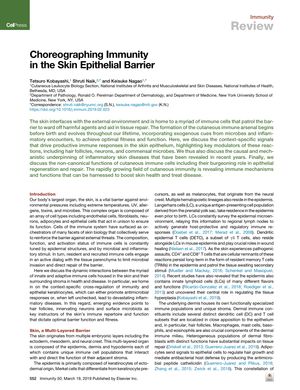Choreographing Immunity in the Skin Epithelial Barrier
March 2019
in “
Immunity
”

TLDR The document concludes that the skin's immune system is complex, involving interactions with hair follicles, nerves, and microbes, and can protect or cause disease, offering targets for new treatments.
The document from March 1, 2019, provides a comprehensive review of the interactions between immune cells and the skin epithelium, with a focus on the role of hair follicles, neurons, and commensal microbes in modulating immune responses. It discusses how context-specific signals can lead to protective immune reactions or contribute to inflammatory skin diseases if dysregulated. The review also covers the non-traditional roles of immune cells in epithelial regeneration and repair, the evolution of the skin's immune system from before birth, and the differences between human and mouse skin immunity. It explores the unique immune microenvironments of different skin regions, the influence of epithelial cells on immune cell localization and retention, and the potential of targeting immune-epithelial interactions to treat skin diseases. The document also highlights the importance of cytokines in maintaining skin-resident immune cells, their role in hair follicle stem cell activation and hair growth, and their involvement in skin diseases. Additionally, it examines keratinocytes as immune sentinels and their role in inflammatory skin diseases, the interaction between immune cells and neurons, and the cross-regulation between host immunity and the skin microbiota. Lastly, it discusses the role of commensal bacteria in skin health, the role of immune cells in tissue repair, the concept of immune memory in skin epithelial stem cells, and the potential of microbiota-based therapies for inflammatory skin diseases.












